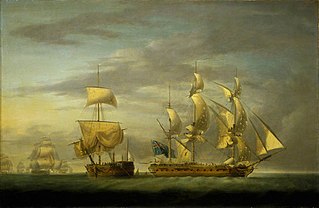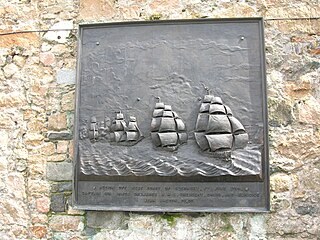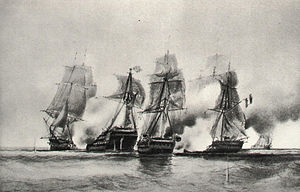
Louis-Thomas Villaret de Joyeuse was a French admiral.

Jean-Baptiste Philibert Willaumez was a French naval officer and nobleman who served during the French Revolutionary Wars and Napoleonic Wars. Willaumez joined the French Navy at the age of 14, and proved to be a competent sailor. Having risen to the rank of pilot, he started studying navigation, attracting the attention of his superiors up to Louis XVI himself. Willaumez eventually became an officer and served under Antoine Bruni d'Entrecasteaux in his expedition to rescue Jean-François de Galaup, comte de Lapérouse and explore the Indian Ocean and Oceania.

HMS Thames was a 32-gun Richmond-class fifth-rate frigate of the Royal Navy built by Henry Adams and launched at Bucklers Hard in 1758. She served in several wars, including for some four years in French service after her capture. She was recaptured in 1796 and was broken up in 1803.

Révolutionnaire, was a 40-gun Seine-class frigate of the French Navy, launched in May 1794. The British captured her in October 1794 and she went on to serve with the Royal Navy until she was broken up in 1822. During this service Revolutionnaire took part in numerous actions, including three for which the Admiralty would in 1847 award clasps to the Naval General Service Medal, and captured several privateers and merchant vessels.

Pierre Jean Van Stabel was a French naval officer and rear-admiral, famous for his role in the Glorious First of June.

HMS Santa Margarita was a 36-gun fifth-rate frigate of the Royal Navy. She had been built for service with the Spanish Navy, but was captured after five years in service, eventually spending nearly 60 years with the British.

Cybèle was a Nymphe-class 40-gun frigate of the French Navy.

The Sunda Strait campaign of January 1794 was a series of manoeuvres and naval actions fought between warships and privateers of the French Republic and a squadron of vessels sent by the British East India Company to protect trade in the region, later augmented by Dutch warships. The campaign developed as French forces based on Île de France reacted more quickly than the British forces in the Indian Ocean to the expansion of the French Revolutionary Wars on 1 February 1793. French privateers rapidly spread along the British trade routes in the Far East, becoming concentrated around the narrow Sunda Strait between the islands of Java and Sumatra in the Dutch East Indies. These ships were soon joined by French Navy frigates and began to inflict losses on shipping in the region. The Royal Navy forces in the Indian Ocean were deployed elsewhere and so the East India Company, the private enterprise that ruled much of British India in the 1790s and maintained their own fleet and navy, raised a squadron of armed merchant ships to patrol the Strait and drive off the raiders.
The action of 5 May 1794 was a minor naval engagement fought in the Indian Ocean during the French Revolutionary Wars. A British squadron had been blockading the French island of Isle de France since early in the year, and early on 5 May discovered two ships approaching their position. As the strange vessels came closer, they were recognised as the French frigate Duguay Trouin, which had been captured from the East India Company the year before, and a small brig. Making use of a favourable wind, the British squadron gave chase to the new arrivals, which fled. The chase was short, as Duguay Trouin was a poor sailor with many of the crew sick and unable to report for duty. The British frigate HMS Orpheus was the first to arrive, and soon completely disabled the French frigate, successfully raking the wallowing ship. After an hour and twenty minutes the French captain surrendered, Captain Henry Newcome of Orpheus taking over the captured ship and bringing his prize back to port in India.

Forte was a French 42-gun frigate, lead ship of her class.

The Battle of Île Ronde was a minor naval engagement between small French Navy and British Royal Navy squadrons off Île de France, now named Mauritius, in the early stages of the French Revolutionary Wars. The battle was fought over control of the waters around Île de France, which was under blockade from the British squadron as French warships and privateers operating from the island posed a significant threat to vital British trade routes connected to British India and China.

His Majesty's hired armed lugger Valiant served the Royal Navy on a contract from 5 May 1794 to 10 November 1801. She was of 109 90⁄94 tons (bm), and was armed with eleven 3-pounder guns.
Numerous French naval vessels have borne the name Résolue, the French for "Resolute", as have several privateers.
Princess Royal, launched in 1786, was an East Indiaman. She made two complete trips to India for the British East India Company (EIC) and was on her third trip, this one to China, when French privateers or warships captured her on 27 September 1793. The French Navy took her into service in the Indian Ocean as a 34-gun frigate under the name Duguay Trouin. The Royal Navy recaptured her and she returned to British merchant service. In 1797 she performed one more voyage for the EIC. She received a letter of marque in July 1798 but was captured in October 1799 off the coast of Sumatra.

During the late 18th and early 19th centuries, many French privateers and letters of marque bore the name Duguay-Trouin, named for René Duguay-Trouin: René Trouin, Sieur du Gué, French privateer, admiral and Commander in the Order of Saint Louis. Between 1760 and 1810, warships of the Royal Navy captured seven different French privateers all with the name Duguay-Trouin.
The action of 9 February 1799 was a minor naval engagement of the French Revolutionary Wars between a British Royal Navy frigate and a French privateer frigate fought 100 nautical miles (190 km) west of the southeastern coast of what is now Natal in South Africa. The 32-gun French frigate Prudente had since the start of the war been part of a squadron operating from Île de France. This squadron had dispersed during 1798, with the ships sent on independent commerce raiding operations across the British trade routes in the Indian Ocean. Prudente had subsequently been seized in the autumn of that year by Anne Joseph Hippolyte de Maurès, Comte de Malartic, the Governor of Île de France, and sold to a private raiding company.
Numerous French privateers have borne the name Vengeur ("Avenger"):
HMS Stag was a 32-gun fifth-rate frigate built for the Royal Navy. She was ordered in 1790 and work began in March 1792 at Chatham Docks. Completed in August 1794, Stag spent much of her service in home waters, where she worked to protect British shipping from French privateers. In an action on 22 August 1795, Stag engaged, and forced the surrender of, the Dutch frigate Alliante, and took part in the chase that ended with the capture of Bonne Citoyenne by HMS Phaeton on 10 March 1796.
Naïade was a 20-gun Coquette-class corvette. She took part in the Indian theatre of the Anglo-French War with the squadron under Suffren. The British Royal Navy captured her in 1783 but never commissioned her; it sold her in 1784.












